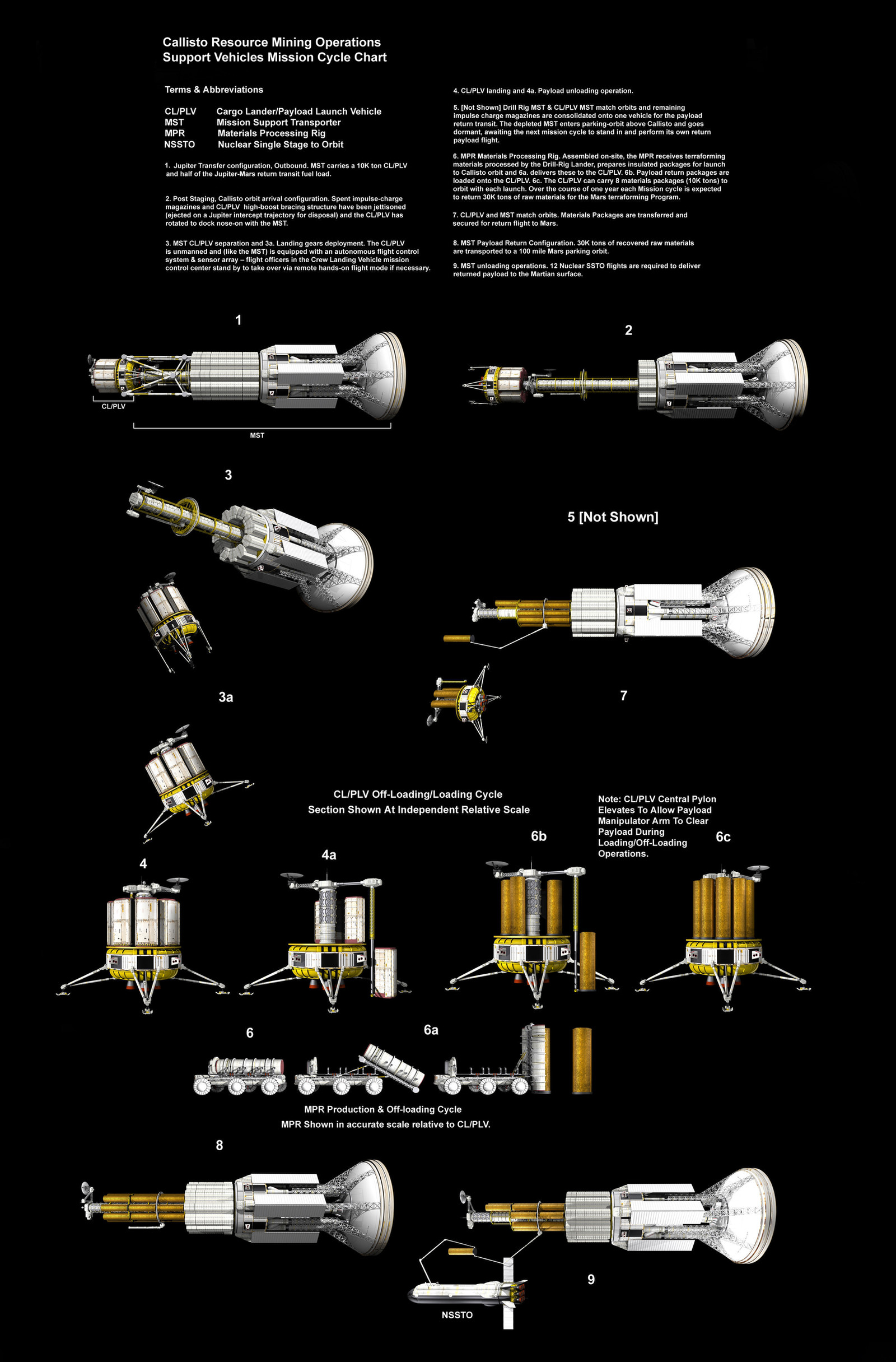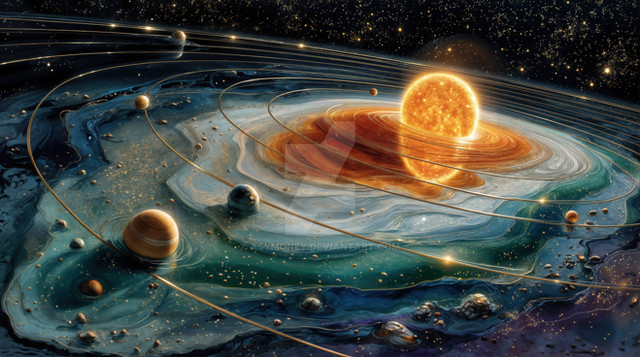HOME | DD
 William-Black — Callisto Resource Mining Mission Cycle Chart
William-Black — Callisto Resource Mining Mission Cycle Chart

Published: 2014-10-20 01:27:01 +0000 UTC; Views: 26857; Favourites: 206; Downloads: 0
Redirect to original
Description
Full Resolution Digital Print: $6.00Orders can be placed at wblack42@sbcglobal.net
See my profile page for details.
Callisto Resource Mining Operations Support Vehicles Mission Cycle Chart
Vehicle and mission concept created for my Orion’s Arm Future History ,synopsis at the link.
This image details the mission event sequence. I’ve included a key to the specialized abbreviations I use to reference the vehicles in the description.
Each mission-cycle a convoy of three spacecraft depart Mars orbit (after some final assembly on-orbit) bound for Callisto. The Martian’s (see Orion’s Arm Glossary, scroll down to Martian’s) launch these missions year after year, decade after decade for hundreds of years.
Callisto resource mining operations employ a nuclear powered drill-rig, used to recover water and ammonia, these are and separated and an electrolysis plant produces hydrogen and oxygen for rocket fuel, and for use in spacecraft ECLSS. Ammonia is packaged for transport back to Mars for use in a program to terraform the planet.
Ammonia is a powerful greenhouse gas which is used to jump-start the terraforming process.
The program also supplies commercial propellant depots serving mining operations scattered throughout the asteroid belt.
Each convoy of spacecraft includes a crewed vehicle, an unmanned drill-rig/electrolysis plant transport/carrier, and an unmanned mission cargo carrier which hauls a mission-support payload of supplies and equipment aboard a re-usable surface to orbit shuttle which is also tasked to loft materials from the surface of Callisto to the awaiting carrier spacecraft for transport back to Mars.
The mission support transporter is an Orion pulsed fusion spacecraft with an actively-cooled parabolic pusher-plate (note radiator panels mounted on the propulsion module).
Recently Physicist Friedwardt Winterberg, University of Nevada, published a paper describing a nuclear explosive that uses chemical explosives (HMX, specifically) to drive a Deuterium-tritium fusion reaction, without the use of a fission element. If it could be made to work the application benefit for Orion is a reduction in the weight/bulk of the impulse charge load. Further mass reduction would be possible by replacing some of the HMX with Metastable Solid Metallic Hydrogen. With (a theoretical) energy release of 216megajoule/kilogram (compared to HMX = 5.7 Mj/kg), only 2.6 percent as much metallic hydrogen would be needed. With a density of about 0.9 gm.cm^3, about 5.5% the volume of HMX converted to metallic hydrogen provides the same bang along with an additional weight/bulk savings.
The parabolic pusher-plate carries a materials-technology challenge of crafting materials which are both extremely strong and extremely flexible.
For a detailed image of the Drill Rig Landing Craft, the Reusable Surface-to-Orbit shuttle and the surface crawler/transporter, and operations on the surface of Callisto see Callisto Production Field
On my Orion's Arm timeline this image would fall during the Outer Solar System Frontier Era, see journal entry at the link for further details.
Image is part of the series of works to be found in my Outer Solar System Frontier Gallery.
References:
Let's Design An Atom Bomb
Fission-free fusion
Hybrid Chemical-Nuclear Convergent Shock Wave High Gain Magnetized Target Fusion PDF
Related content
Comments: 12

👍: 0 ⏩: 0

To maximise the coupling between the engine bell and the fusion detonations, the bell needs to be parabolic and the detonation in the focus, thus Winterberg's diagram in his paper.
👍: 0 ⏩: 1

Thanks Adam, "hemispherical" was an unfortunate and unintentionally misleading word-choice on my part. I've corrected the caption to better reflect the design-concept.
👍: 0 ⏩: 0

I love your work! I'm working on a game in which we're trying to be as realistic as possible in the design of spacecraft and the industrial infrastructure of a space-faring civilization. I cite your exemplary space art to my colleagues frequently!
👍: 0 ⏩: 0

Cool and informative. Quite a fascinating mission architecture.
👍: 0 ⏩: 0

Really like all the detail and thought that's gone into this.
👍: 0 ⏩: 0

Would it be easier and more stable to sling the loads directly beneath the crane rather than from the bottom and side like that?
👍: 0 ⏩: 1

Perhaps I should have included a close-in shot of the lift mechanism, much like a fork-lift it is a duel arm load-baring lift fitted with double prongs which plug securely into sockets, (themselves part of the load-baring structure of the container or payload-return pack) the sockets are set into the base of the cargo containers and into the base of return payload packages. So nothing is balanced precariously, the lift plugs right into the structure of the obect it is lifting. Cargo containers would be packed so nothing inside could shift during out-bound transit (you don't want your mission gear bouncing around during high-impulse boost and return-payload packs would be baffled against slosh - it's Callisto, so no wind to set anything swaying, and that double-arm would be very resistive to that kind of motion anyway.
👍: 0 ⏩: 1

The arrangement looks top heavy to me, which isn't a concern with a crane.
👍: 0 ⏩: 1

If you are plugged into the structural frame of the object it shouldn't be an issue. It's really no different than the Canada Arm manipulating the modules for the ISS. Callisto is 0.126 g. In order for the top of the load to shift the structure of the container would have to fail - and so long as the load-master has done his job properly, there is no way for anything inside the container to shift. Its not like they would be dealing with random loads, the system would be designed to handle specific known loads.
👍: 0 ⏩: 1

I keep forgetting just how low the gravity would be.
👍: 0 ⏩: 0


























